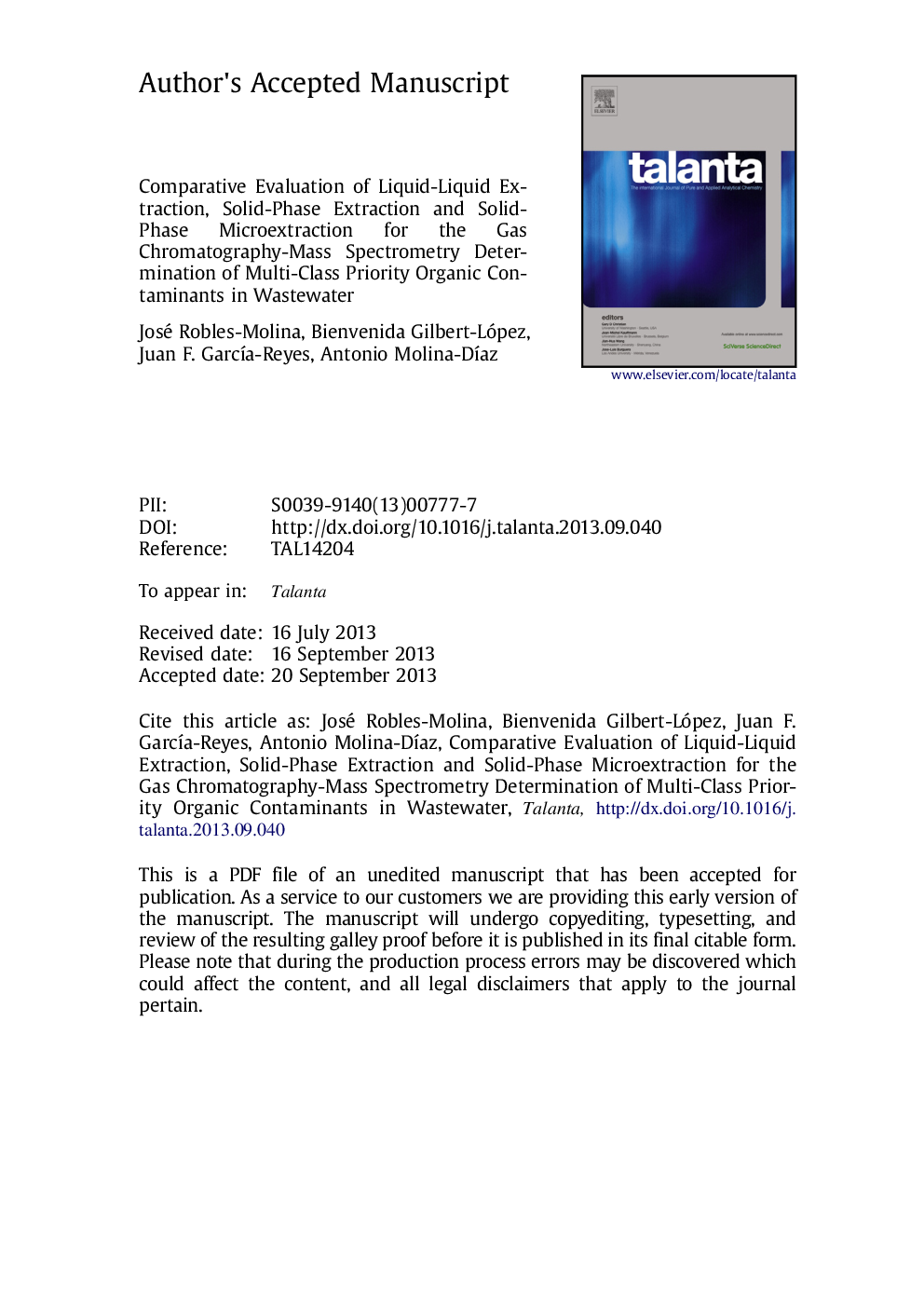| کد مقاله | کد نشریه | سال انتشار | مقاله انگلیسی | نسخه تمام متن |
|---|---|---|---|---|
| 7682175 | 1495818 | 2013 | 31 صفحه PDF | دانلود رایگان |
عنوان انگلیسی مقاله ISI
Comparative evaluation of liquid-liquid extraction, solid-phase extraction and solid-phase microextraction for the gas chromatography-mass spectrometry determination of multiclass priority organic contaminants in wastewater
ترجمه فارسی عنوان
ارزیابی مقایسه ای از استخراج مایع مایع، استخراج جامد فاز و میکرو اکستراکتیو جامد فاز برای تعیین طیف سنجی جرم کروماتوگرافی گاز از آلاینده های آلی آلاینده های چندگانه در فاضلاب
دانلود مقاله + سفارش ترجمه
دانلود مقاله ISI انگلیسی
رایگان برای ایرانیان
کلمات کلیدی
Priority compoundspesticides - آفتکشهاSolid-phase extraction - استخراج فاز جامدLiquid–liquid extraction - استخراج مایع مایعsolid-phase microextraction - بیوفیزیک جامد فازSample treatment - درمان نمونهWater Framework Directive (WFD) - دستورالعمل چارچوب آب (WFD)Mass spectrometry - طیف سنجی جرمیWastewater - فاضلاب یا پسابPAHs - هیدروکربن های آروماتیک چند حلقه ایGas chromatography - کروماتوگرافی گازی
موضوعات مرتبط
مهندسی و علوم پایه
شیمی
شیمی آنالیزی یا شیمی تجزیه
چکیده انگلیسی
The European Water Framework Directive (WFD) 2000/60/EC establishes guidelines to control the pollution of surface water by sorting out a list of priority substances that involves a significant risk to or via the aquatic systems. In this article, the analytical performance of three different sample preparation methodologies for the GC-MS/MS determination of multiclass organic contaminants-including priority comprounds from the WFD-in wastewater samples using gas chromatography-mass spectrometry was evaluated. The methodologies tested were: (a) liquid-liquid extraction (LLE) with n-hexane; (b) solid-phase extraction (SPE) with C18 cartridges and elution with ethyl acetate:dichloromethane (1:1 (v/v)), and (c) headspace solid-phase microextraction (HS-SPME) using two different fibers: polyacrylate and polydimethylsiloxane/carboxen/divinilbenzene. Identification and confirmation of the selected 57 compounds included in the study (comprising polycyclic aromatic hydrocarbons (PAHs), pesticides and other contaminants) were accomplished using gas chromatography tandem mass spectrometry (GC-MS/MS) with a triple quadrupole instrument operated in the multiple reaction monitoring (MRM) mode. Three MS/MS transitions were selected for unambiguous confirmation of the target chemicals. The different advantages and pitfalls of each method were discussed. In the case of both LLE and SPE procedures, the method was validated at two different concentration levels (15 and 150 ng Lâ1) obtaining recovery rates in the range 70-120% for most of the target compounds. In terms of analyte coverage, results with HS-SPME were not satisfactory, since 14 of the compounds tested were not properly recovered and the overall performance was worse than the other two methods tested. LLE, SPE and HS-SPME (using polyacrylate fiber) procedures also showed good linearity and precision. Using any of the three methodologies tested, limits of quantitation obtained for most of the detected compounds were in the low nanogram per liter range.
ناشر
Database: Elsevier - ScienceDirect (ساینس دایرکت)
Journal: Talanta - Volume 117, 15 December 2013, Pages 382-391
Journal: Talanta - Volume 117, 15 December 2013, Pages 382-391
نویسندگان
José Robles-Molina, Bienvenida Gilbert-López, Juan F. GarcÃa-Reyes, Antonio Molina-DÃaz,
